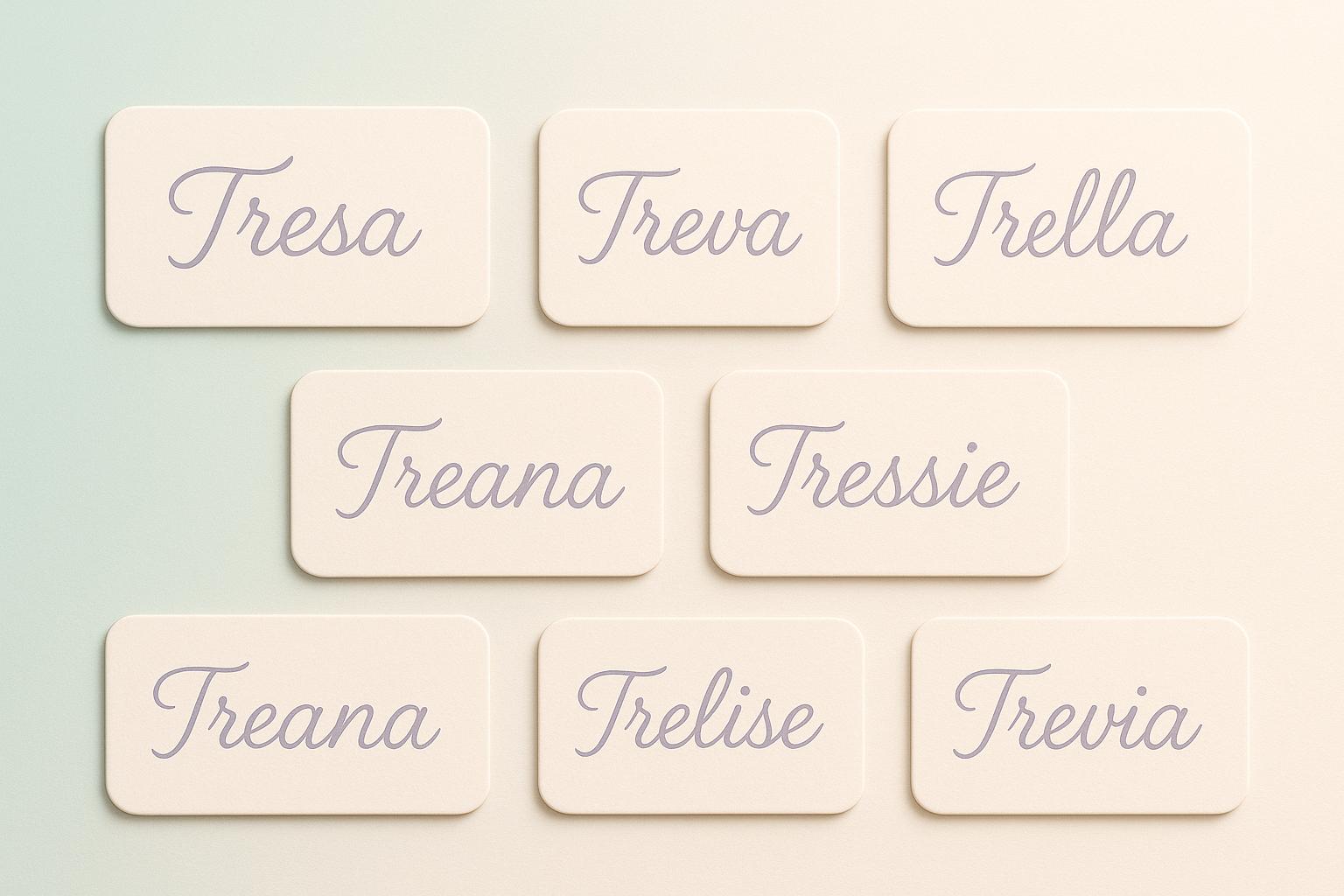Your child’s name is a lifelong label, and while you can’t control every situation, picking a name that avoids common pitfalls can help them feel confident and avoid unnecessary teasing. Here's how to make a thoughtful choice:
- Keep pronunciation and spelling simple: Avoid names with unusual spellings or ones that are hard to pronounce. Test the name with others to spot potential issues.
- Think about nicknames: Brainstorm possible shortened forms or variations to ensure they won’t lead to teasing.
- Check for rhymes and teasing potential: Say the name out loud to identify any rhymes or associations kids might exploit.
- Consider pop culture and social ties: Avoid names tied to controversial figures or characters that could overshadow your child’s identity.
- Test for awkward meanings or initials: Ensure the name doesn’t unintentionally form negative words or phrases.
- Work with your partner: Use tools like NameHatch to collaborate and find names you both like.
A well-chosen name can help your child navigate social situations with greater ease and confidence. Use these tips to make a choice that feels right for your family.
1. Check Pronunciation and Spelling
The first step to picking a name that’s less likely to invite teasing is ensuring it’s simple to say and spell. A name that’s constantly mispronounced or misspelled can lead to frustration, especially for a child who will spend years introducing themselves.
Think about it: kids hear their names called out in classrooms, during roll call, or in casual conversations. A name that trips people up can make these everyday moments unnecessarily complicated. Let’s explore how to sidestep these issues.
Avoid Unusual or Confusing Spellings
While it might be tempting to give a traditional name a unique twist, unconventional spellings often create more headaches than they’re worth. For example, spelling "Jackson" as "Jaxsyn" might seem creative, but it could leave your child constantly correcting others.
Names with unexpected spellings can be especially tricky when the written form doesn’t match how the name sounds. Take "Ashleigh", for instance - someone unfamiliar with it might mistakenly say "Ash-lay." Or consider "Jaymz", which could confuse people expecting the standard "James."
These mix-ups aren’t just a childhood issue. They can follow someone into adulthood, turning into a lifelong source of irritation. While these might seem like small annoyances, over time, they can add up and become genuinely bothersome.
Once you’ve chosen a name that feels right, it’s time to see how it holds up in real-world scenarios.
Try the Name Out on Others
Before finalizing your decision, test the name with other people to uncover potential pronunciation challenges. This step is essential, especially if you’ve been saying the name in your head for months and might not notice its quirks.
Ask a mix of people to read the name aloud and spell it back to you. Their first reactions can be incredibly telling. If several people stumble over the pronunciation or interpret it differently than you intended, that’s a sign the name might cause confusion.
Broaden your test group. Seek feedback from individuals with different backgrounds to catch pronunciation issues you might not have thought of. This diversity can highlight potential challenges that could arise in various settings.
2. Review Nickname Possibilities
Once you’ve settled on a name with clear pronunciation and spelling, it’s time to think about potential nicknames. Just as you’ve worked to avoid mispronunciations, considering how the name might evolve into nicknames can help sidestep future teasing.
Even the most carefully chosen names can take on unexpected forms. Kids have a knack for shortening or twisting names in ways you might not anticipate. By exploring these possibilities ahead of time, you can minimize the risk of your child encountering unwanted attention or teasing.
Explore Common Nickname Variations
Start by brainstorming how the name might naturally shorten. Some names have obvious nicknames, while others might surprise you with less predictable variations.
For instance, "Richard" often becomes "Rick" or "Rich", but historically, it’s also been shortened to "Dick" - a nickname that could lead to teasing in modern contexts. Similarly, "Benjamin" might turn into "Ben" (a safe bet) or "Benji", which could be more prone to playful teasing. "Christopher" might shorten to "Chris", but it could also become "Christy", depending on the crowd.
Pay attention to both the beginning and ending sounds of the name. These sounds often inspire nicknames or wordplay. Try saying the name aloud and consider how kids might manipulate it into something humorous - or even mean-spirited.
Avoid Names That Rhyme with Teasing Words
Names that rhyme with teasing words are an easy target for children’s playful (and sometimes cruel) creativity. Be mindful of names that might rhyme with body parts, bathroom humor, or common insults. Kids naturally gravitate toward rhymes, and these can quickly turn into a source of teasing.
For example, names like "Mary" could end up as "Scary Mary" or "Hairy Mary", depending on how they’re pronounced. Regional accents can also play a role. A name that sounds harmless in one area might take on a teasing rhyme in another.
To avoid these pitfalls, say the name out loud multiple times, experimenting with different pronunciations and emphasis patterns. Shorten it, stretch it, and imagine how a child might twist it into a rhyme or joke. If you can easily spot a teasing opportunity, chances are other kids will too.
3. Check Pop Culture and Social Connections
Names often come with associations that stick with children throughout their lives. A name that seems harmless on paper might be tied to a celebrity, a fictional character, or even a viral trend. These connections can sometimes lead to teasing or unwanted attention from peers.
Even names that feel timeless can carry the weight of a well-known figure or character, shaping how others perceive your child. While positive associations might seem harmless, they can sometimes overshadow a child's individuality.
Watch Out for Pop Culture References
Think about whether a name's connection to pop culture could dominate your child's identity or lead to recurring jokes. The way a name is viewed can change quickly with trends in media or current events.
Once you've confirmed that a name is easy to pronounce and has friendly nickname options, take a moment to consider its broader cultural and social implications.
Consider Regional Popularity
It’s also worth checking how common a name is in your area. A name that's extremely rare might make a child feel singled out, while one that's overly popular could lead to confusion in school or other group settings. Regional differences play a role, too - a name that feels perfectly at home in one community might stand out or even seem unusual in another. Looking into local naming trends can give you a better idea of how a name might be received where you live.
Striking a balance between familiarity and distinctiveness can make a big difference. A name that feels unique yet approachable can help your child feel confident while avoiding unnecessary teasing.
4. Test for Negative Meanings or Sounds
Sometimes, a name that seems harmless on paper can take on unintended meanings or awkward sounds when spoken aloud. What feels neutral in your mind might shift in tone or invite teasing when said in different contexts. The way syllables connect, how the name pairs with a last name, or even potential mispronunciations can all lead to issues you might not have anticipated.
Say the Name Out Loud
It’s important to say the full name in various situations - like during roll call, in casual conversation, or even as if it’s being announced at an event. This helps uncover any awkward or unexpected sound combinations.
Pay close attention to how the first and last names flow together. Sometimes, the ending of one name and the beginning of the next can blend in ways that create unintended words or phrases. For example, a perfectly fine first name might combine with a last name to produce something that sounds strange or even humorous.
You can also test the name with common phrases or scenarios. Imagine how it might sound when shouted across a playground, spoken over a loudspeaker at graduation, or used in formal settings. This can help identify any potential issues with pronunciation or flow that might not be obvious at first.
Avoid Negative Sound-Alikes
Be cautious of names that sound like negative words, even with slight pronunciation differences. Names that rhyme with or resemble words related to bodily functions, insults, or undesirable traits can quickly become a source of teasing. While adults might overlook these connections, kids often pick up on them - and they can be surprisingly creative when it comes to nicknames or wordplay.
Think about how the name might be shortened or altered. A seemingly harmless name could develop an unfortunate nickname or variation that leads to teasing.
Initials are another factor to consider. While they might not seem important, initials appear on things like school rosters, official documents, and even name tags. Combinations like "SAD", "BAD", or worse can cause embarrassment over time.
Finally, if you live in a diverse community, think about how the name translates across different languages. A name that works perfectly in English might carry negative connotations in Spanish, Mandarin, or other languages your child might encounter, potentially leading to misunderstandings or teasing in multicultural settings.
sbb-itb-f13f980
5. Work with Your Partner
Picking a baby name together can be tricky. Disagreements over names are very common, but the good news is that most couples eventually land on a name they both love. It just takes some patience and the right approach.
Think of name selection as a team effort. If one of you feels strongly about a name and the other doesn’t, it’s easy to get frustrated. Instead of treating disagreements as obstacles, view them as opportunities to explore names that truly resonate with both of you. This mindset can make the process more collaborative and productive.
Review Names Together
Clear communication is key, but adding some structure can make the process smoother. One popular strategy is the "two yeses and one no" rule - a name only stays on the list if both of you like it. If either of you vetoes it, it’s off the table. This ensures the final choice has mutual support.
NameHatch's partner matching feature can make this easier. When both of you swipe right on the same name, the app notifies you of the match. This cuts out the guesswork and helps you focus on names you both like.
The swipe-based system also softens the impact of disagreements. Instead of one partner having to reject the other’s favorite name directly, the app simply highlights the names where your preferences align. It’s a more neutral, less emotional way to navigate differences in taste.
Revisit and Update the Shortlist
Your opinions on names might shift over time. Set aside time every few weeks to review your shortlist together and see if the names still feel right. Reassessing names can help you spot potential issues with pronunciation, nicknames, or associations you hadn’t considered before.
Sometimes a name that seemed perfect at first might lose its appeal after some thought, while others you initially dismissed might grow on you. Saying names out loud in everyday contexts can also help you decide if they feel natural and practical for your child’s daily life.
If you’re using NameHatch, you can save and organize your favorite matches, making it easy to revisit names you both liked in the past. The app’s AI-powered suggestions can also introduce fresh options based on the patterns of names you’ve already approved, helping you discover new possibilities.
Interestingly, 91% of parents surveyed said they would choose the same name again if given the chance. This shows that when couples take the time to work through their differences thoughtfully, they usually end up confident and happy with their choice for years to come.
6. Use Tools to Make the Process Easier
Going through this checklist manually can feel overwhelming, especially when you're already deep in pregnancy preparations and juggling countless decisions. Thankfully, modern tools can make the name selection process smoother and help you apply these bully-proofing criteria more efficiently.
Digital platforms can sift through thousands of names, leaving you to focus on the ones that truly resonate with you and your partner. With smart filters and AI-powered suggestions, you can narrow down your options without the headache.
Smart Filters for Better Name Suggestions
One great example is NameHatch's filtering system, which automatically applies key criteria from your checklist. Their smart filters are categorized into groups like Classic, Modern, Soft, and Strong, helping you steer clear of names that might invite teasing or mispronunciations.
- The Classic filter highlights timeless choices like William, Elizabeth, or Michael - names that have long been admired for their simplicity and resilience against mockery.
- For something less traditional, the Modern filter focuses on contemporary names that feel fresh without being too unfamiliar.
If you’re looking for something more specific, premium filters can refine your search further. Options like Nature-Inspired (e.g., River, Sage) or Global names are designed to work seamlessly in English-speaking settings. These filters take into account factors like pronunciation ease, cultural familiarity, and social acceptance - all key elements of the bully-proofing checklist.
Once you’ve narrowed your list, AI technology steps in to refine your options even more.
AI-Powered Custom Suggestions
NameHatch's AI feature analyzes the names you and your partner like, learning your preferences to recommend others that fit your style while meeting practical criteria. This AI doesn’t just suggest random names; it looks for patterns in your choices to surface options you might not have considered yet.
The technology also takes care of the "testing" phase of the checklist. Instead of manually checking each name for unfortunate rhymes or awkward nicknames, the AI filters out those pitfalls for you. It even factors in regional popularity, helping you avoid names that might feel too trendy or out of place in your area.
As you save favorites, the AI continues to refine its suggestions, becoming more tailored to your preferences over time. This means the more you use the platform, the better it gets at finding names that align with both your personal tastes and practical needs.
Conclusion: Finding a Name That Builds Confidence
Picking a name that avoids common mispronunciations, unflattering nicknames, or negative associations can help shield your child from unnecessary teasing. This guide offers a practical approach to sidestep typical naming challenges.
It's important to recognize that bullying is a multifaceted issue, and your child's ability to navigate social situations and build resilience will also play a big part in handling any teasing. The aim isn't to choose a name that's entirely immune to criticism - no name is - but to find one that aligns with your family's values while giving your child a solid foundation for confidence.
Modern tools like NameHatch make the name selection process easier with features like smart filters and AI-driven suggestions. Its partner matching feature simplifies collaboration, helping parents align on choices. Discussing potential names with trusted family members can also provide fresh insights into how others might interpret your choices.
A well-thought-out name can boost your child's self-assurance and help them navigate social settings with ease. By following these practical tips, you'll choose a name that not only minimizes teasing but also empowers your child to carry it proudly throughout their life.
FAQs
What can I do to choose a name for my child that reduces the chances of teasing or bullying?
Choosing a name for your child is a big decision, and there are a few things to keep in mind to make it a positive one. Pick a name that’s simple to pronounce, shows respect for your heritage or background, and steers clear of any negative associations. It’s also a good idea to think about how the name might be shortened into nicknames or initials - some combinations can lead to teasing or awkward situations.
Another factor to consider is how the name will sound in everyday settings, like in a classroom or on the playground. While it’s impossible to completely shield a child from teasing, helping them build confidence and self-assurance can make a huge difference in how they handle any tough moments.
How can I test a baby name's pronunciation and potential nicknames before deciding?
When deciding on a name, try saying it out loud a few times to see how it sounds and flows naturally. Pay attention to how it works with your last name and whether it feels easy to say in everyday conversations.
It’s also helpful to think about potential nicknames or abbreviations - both the ones you might choose and those that could come up unintentionally. If you’re uncertain, imagine using the name in everyday situations, like during roll call or when introducing your child to others. These small steps can help you feel more confident in your choice and reduce the chances of mispronunciation or teasing.
Why should I think about pop culture and social trends when naming my child?
When choosing a name for your child, it’s worth thinking about pop culture and current social trends. Names inspired by popular events, celebrities, or media can create a sense of connection to shared experiences, helping your child feel more in tune with their peers and the world around them. These names often carry a sense of familiarity, which can make social interactions a bit easier.
However, trendy names can sometimes come with unintended baggage. They might be linked to stereotypes or specific associations that could affect how others perceive your child. Taking a moment to reflect on these potential connections can go a long way in ensuring the name you choose supports your child’s sense of self and their experiences with others.



